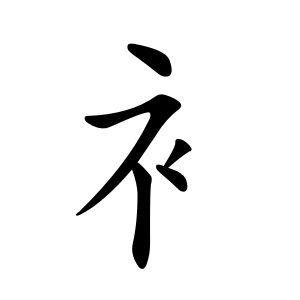Radical 145 on:
[Wikipedia]
[Google]
[Amazon]
 Radical 145 or radical clothes () meaning "
Radical 145 or radical clothes () meaning "
File:衣-oracle.svg,
Unihan Database - U+8863
{{Simplified Chinese radicals 145
 Radical 145 or radical clothes () meaning "
Radical 145 or radical clothes () meaning "clothes
Clothing (also known as clothes, apparel, and attire) are items worn on the body. Typically, clothing is made of fabrics or textiles, but over time it has included garments made from animal skin and other thin sheets of materials and natural ...
" is one of the 29 Kangxi radical
The 214 Kangxi radicals (), also known as the Zihui radicals, form a system of radicals () of Chinese characters.
The radicals are numbered in stroke count order. They are the most popular system of radicals for dictionaries that order Traditi ...
s (214 radicals in total) composed of 6 strokes
Stroke (also known as a cerebrovascular accident (CVA) or brain attack) is a medical condition in which poor blood flow to the brain causes cell death. There are two main types of stroke: ischemic, due to lack of blood flow, and hemorrhagic, ...
. The radical character transforms into when appearing at the left side of a Chinese character.
In the ''Kangxi Dictionary
The ''Kangxi Dictionary'' ( (Compendium of standard characters from the Kangxi period), published in 1716, was the most authoritative dictionary of Chinese characters from the 18th century through the early 20th. The Kangxi Emperor of the Qing ...
'', there are 607 characters (out of 49,030) to be found under this radical
Radical may refer to:
Politics and ideology Politics
* Radical politics, the political intent of fundamental societal change
*Radicalism (historical), the Radical Movement that began in late 18th century Britain and spread to continental Europe an ...
.
is also the 142nd indexing component in the ''Table of Indexing Chinese Character Components ''The Table of Indexing Chinese Character Components'' () is a lexicographic tool used to order the Chinese characters in mainland China. The specification is also known as GF 0011-2009.
In China's normative documents, "radical" is defined as any ...
'' predominantly adopted by Simplified Chinese
Simplification, Simplify, or Simplified may refer to:
Mathematics
Simplification is the process of replacing a mathematical expression by an equivalent one, that is simpler (usually shorter), for example
* Simplification of algebraic expressions ...
dictionaries published in mainland China
"Mainland China" is a geopolitical term defined as the territory governed by the People's Republic of China (including islands like Hainan or Chongming), excluding dependent territories of the PRC, and other territories within Greater Chin ...
, with as its associated indexing component.
Evolution
Oracle bone script
Oracle bone script () is an ancient form of Chinese characters that were engraved on oracle bonesanimal bones or turtle plastrons used in pyromantic divination. Oracle bone script was used in the late 2nd millennium BC, and is the earliest kno ...
character
File:衣-bronze.svg, Bronze script
Chinese bronze inscriptions, also commonly referred to as bronze script or bronzeware script, are writing in a variety of Chinese scripts on ritual bronzes such as ''zhōng'' bells and '' dǐng'' tripodal cauldrons from the Shang dynasty (2nd m ...
character
File:衣-bigseal.svg, Large seal script
The large seal script or great seal script () is a traditional reference to Chinese writing from before the Qin dynasty (i.e. before 221 BCE), and is now popularly understood to refer narrowly to the writing of the Western and early Eastern Zho ...
character
File:衣-seal.svg, Small seal script
The small seal script (), or Qin script (, ''Qínzhuàn''), is an archaic form of Chinese calligraphy. It was standardized and promulgated as a national standard by the government of Qin Shi Huang, the founder of the Chinese Qin dynasty.
Name ...
character
Derived characters
Literature
*External links
Unihan Database - U+8863
{{Simplified Chinese radicals 145
142 142 may refer to:
* 142 (number), an integer
* AD 142, a year of the Julian calendar
* 142 BC
__NOTOC__
Year 142 BC was a year of the pre-Julian Roman calendar. At the time it was known as the Year of the Consulship of Calvus and Servilianus (o ...